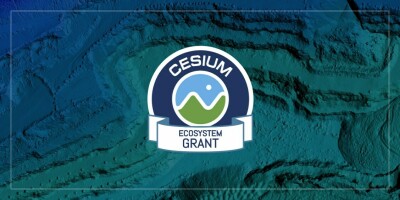Although there have been some reputational setbacks to the general idea of “the metaverse,” most still agree that the future will be, in some form, revolving around 3D representations of the real world. What exactly that looks like is still a mystery, but we’re already starting to see industrial settings skew towards this idea. The key to both that and the broader social use cases that can come in 3D visualizations require extremely accurate location data, putting the geospatial industry at the center of many of these developments. It’s also true that, if this idea is going to mature into what many think it can be, companies are going to need to work together and develop standards and a willingness to develop open source creations, as no one organization or company will be able to build something so vast by themselves.
Cesium is one of the companies most embodying this idea, with their CEO Patrick Cozzi even co-hosting a successful podcast called “Building the Open Metaverse.” Last week, the company made an announcement putting their money where their mouth is. Cesium announced that they are opening up a pool of $1 million in funding with their new Cesium Ecosystem Grants program. These grants, which will range from $5,000 to $50,000 – individuals will be eligible for grants up to $15,000 – will “provide non-dilutive financial support for early stage startups, individuals, educators, and students,” per the company’s official release with the news. Themes for submissions can include, but are not limited to:
Open source contributions - to Cesium or the 3D geospatial ecosystem;
Open Standards, multi-project integrations, documentation, or open data.
Academic curriculum development;
3D geospatial projects for the social good.
The company says it is looking to “promote innovation, interoperability, and collaboration in the 3D geospatial ecosystem,” with Cesium Ecosystem Grants, and are focused on ensuring smaller and younger organizations and individuals can break into this space. There is a recognition that not all great ideas are going to come from established sources, and in order to get some of these other innovations off the ground outside support is needed. Crucially, Cesium is putting as few limits as possible on applicants in order to attract the widest pool of candidates they can, noting on their website that grants are open to anyone “regardless of demographic, institution, or industry,” and that projects in any stage, “from ideation to in-process” are eligible for consideration. Applicants will be selected based on the following criteria:

Impact: The project has a clear impact beyond the grantee with specific deliverables and next steps.
Innovation: The project explores and builds the 3D geospatial ecosystem in creative and original ways.
Viability: Project is realistic and achievable. Your needs and plan are clear with the correct team and infrastructure to achieve stated project deliverables.
Ecosystem Inclusion: Grant will promote increased diversity of 3D geospatial ecosystem.
Ecosystem Built on Openness: Applications made in the spirit of a commitment to openness will be favored.
Although grants in scientific fields are certainly not a new thing, this particular program is an encouraging one from the perspective of someone not working directly in the industry but who stands to benefit from gains made by those within. That openness discussed at the top really is crucial for 3D technology to reach its full potential, and here Cesium is looking to specifically harness those ideals to further the space. We should also note that, in addition to financing, grantees will also have access to the Cesium team to further their own growth in the space, as well as be open to joint marketing activities.
It’s also notable that, at least in some ways, these grants are no strings attached. On the one hand, grantees in most cases will receive just 50 percent of their funding up front, with the other half coming after deliverables are hit, but importantly they will not be giving up any ownership in their ideas. Cesium has made sure to note that any grantee will retain full IP and ownership over their work, and that non-Cesium projects are also eligible, as “grants are meant to positively impact the 3D geospatial ecosystem.”
That these grants are not only targeting commercial grantees, but also academics and students, merits mention as well. There are many use cases for these 3D geospatial solutions that may not necessarily be huge money makers, but can do a tremendous amount of good for the world, and many of these are developed in academic settings. Furthermore, many students will of course eventually join the commercial space, and being able to work on viable projects with legitimate funding as they are just starting in the industry should only lead to more profound innovation moving forward as they build off that initial base of working knowledge.
"Ever since the earliest days of open source CesiumJS, the community has consistently inspired us by what they built with 3D geospatial and how they connect together an open and interoperable ecosystem," said Cesium CEO Patrick Cozzi in a press statement. "Well over a decade later, we believe 3D geospatial is only entering its prime for innovation and adoption across many markets. We hope Cesium Ecosystem Grants spark creativity, encourage risk taking, and help launch your game-changing ideas. It's an honor for Cesium to be able to give back in this capacity."
For those interested in learning more about this program, Cesium is holding a live webinar on April 18.






